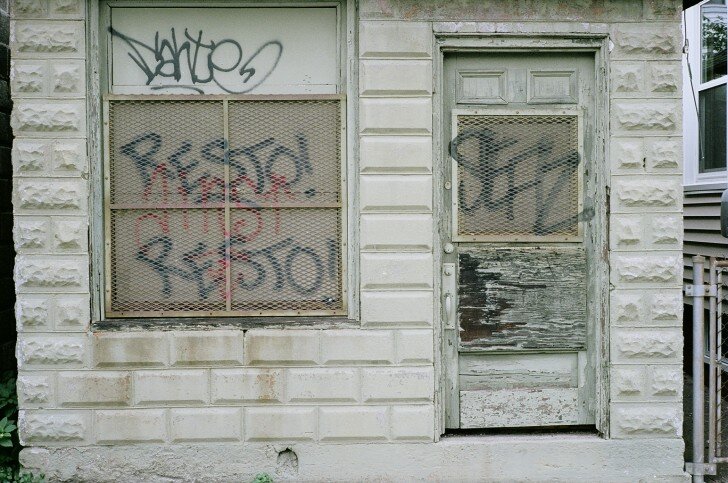William Morgan: For creative responses to the graffiti challenge
After a seemingly endless rampage of city-blighting graffiti, the mayor recently announced that the police had finally identified and charged the most notorious tagger who "soiled hundreds of walls and buildings." The alleged culprit could get two years in prison for defacing property, "which had to be cleaned using public funds."
Dumpster on Providence’s Smith Hill.
— All photos by William Morgan.
This was welcome news, as most citizens regard as vandalism the bubble signatures and symbols painted on blank walls, mailboxes, dumpsters, and electrical boxes. Some lawmakers, however, protested that graffiti was a minor issue, while one accused the mayor of cracking down on graffiti as "a way to forge political consensus."
The mayor, however, is not Jorge Elorza of Providence, but the mayor of Rome, Virginia Raggi, and the alleged tagger was identified as “Geco” (no full name given).
But whether it's Providence or the Eternal City, the problem of such urban defacement is old as human settlement. The ancient Romans battled it, as did the Egyptians centuries before that. During World War II, American G.I.s' painted “Kilroy Was Here’’ on walls from Anzio to Guadalcanal. Like the poor, graffiti will always be with us.
On Ives Street, in Providence’s Fox Point neighborhood.
Called tagging, painting your name in bold letters on the side of a building or a railroad car is about self-expression. Free spirits, the rebellious, and the disenfranchised tag their names to declare that they exist. According to Paolo von Vacaro, an authority on graffiti, "You tag your name to show that you are king of the street."
Competing artists lay their claims to a Providence wall.
As with many forms of self-expression, one man's creative genius is another's vandalism. One might admire the styles of particular graffitists, or how practitioners have artistic duels on public walls. But when the walls are historical, such as Providence Marine Corps of Artillery Arsenal, on Benefit Street, in a section of the city known for its historic architectural beauty, then graffiti is, according to the City of Providence, "a public nuisance and destructive of the rights and values of property owners as well as the entire community."
Defacing the Arsenal, the David Macaulay mural on I-95, or the Providence River pedestrian bridge is unacceptable. If residents and business are really stung by tagging, then they should push the city to get really serious about apprehending the spray-can brigade, and mete out fines stiff enough to cover the restoration of damaged walls and objects.
But how much of a public nuisance is the run-of-the-mill graffiti that covers so many walls, particularly in less affluent neighborhoods? Does it threaten the commonweal? Does painting freight cars make them less efficient? Or are the giant bubble letters symbolic of deeper strains within the community?
Masterpiece of railroad freight car graffiti.
Visual pollution is as unfortunate as it is indefinable: a certain building may enhance or offend, one man's Christmas lights may seem tacky to his neighbors. Graffiti, like smut (the late Supreme Court Justice Potter Stewart declared that he could not define smut, but knew it when he saw it), may be impossible to eradicate.
One of many injury law billboards.
If we are to tackle a city's visual pollution, why not eradicate the billboards that are a blot on the cityscape? As soon as you pass border signs admonishing you to “Discover Beautiful Rhode Island,’’ there are billboards touting one personal-injury law firm after another. (A traveler crossing Rhode Island for the first time might wonder if we do nothing here but chase ambulances)
Rocky and Bullwinkle mural visible from the train, by a 21st-Century Leonardo.
Why not a creative solution for the Creative Capital? If graffiti is a fact of city life, why not embrace it? The destruction of property should be discouraged by strict law enforcement, but the vibrancy of famous artist-provocateurs such as Banksy and Jean-Michel Basquiat should be encouraged. Why not embrace it?
How about hosting a graffiti conference and contest, where local talent and free-spirited geniuses from all over America would come to compete for a national title? Blank walls on warehouses, factories, and other structures would be donated. Providence businesses could sponsor walls, the Rhode Island School of Design could offer a residency for certain artists, and there could be conferences on tagging, along with publications, and maybe even art-school scholarships for disadvantaged would-be artists. Such an event could boost the city on many levels.
Many free-spirited paint bandits might balk at the contra-indication of control, so they would have to continue their vandalism as outlaws. But in the spirit of the successful Gravity Games of 1999-2001, let’s plan for some post-COVID-events that encourage fun, artistic energy, and above all, optimism.
“If your graffiti is exceptional, thank your art teacher’’ says my wife, Carolyn Morgan. Graffiti mural on North Main Street by Jasper Summers..
William Morgan is a Providence-based architectural historian, essayist and photographer. His latest book is Snowbound: Dwelling in Winter






